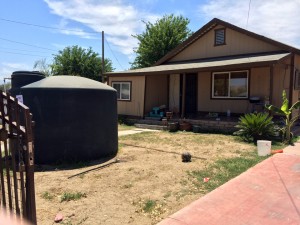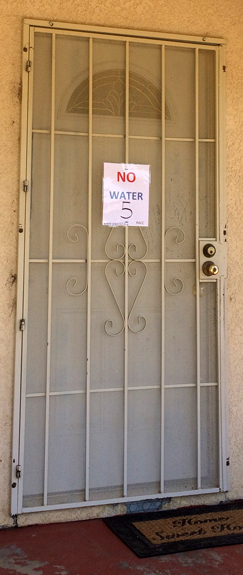When you type “East Porterville” into your trusty search engine, it offers a few suggested phrases before you even get to the “-ville” part: “water crisis” and “drought.” It’s no secret that this part of California is feeling the brunt of our drought, now well into its fourth consecutive summer. But nothing can replace witnessing firsthand the impacts of the drought on some of California’s hardest hit communities.
On a tour through the community of East Porterville in Tulare County last week, I was struck not just by the drought impacts that have been so extensively documented in the media, but also by the way this community is working together – neighbors helping each other, local non-profit organizations offering assistance, and government agencies finding ways to soften the immediate impacts while working toward long-term solutions.
The purpose of our tour was to gain better insight into small drinking water systems in the Southern San Joaquin Valley. Drinking water is a top priority in this region, with places like East Porterville home to hundreds of families whose wells are already dry, and more at risk.
We stopped first at a drug rehabilitation center whose staff and clients are using filtration systems and trying other tools to address nitrates and concerns about other possible contaminants in their water supply.
We also talked to residents who have no running water at all now that their wells have run dry. In this community, most residents rely on individual, private wells rather than a central system. We spoke to one woman whose well dried up, so her neighbor hooked up a hose to help out – until that well went dry, too. In many homes in their community, water is a scarce commodity. Of the 1,600 comes in the community, more than 500 are out of water.

A water tank installed in an East Porterville yard provides a temporary solution during the ongoing drought.
What was most impressive to me was how that problem is being addressed – by a tremendously cooperative effort involving residents, non-profits and government. A non-profit called Self Help works with residents to bring in temporary tanks which are then installed by Community Services Employment Training, Inc. (CSET) Sequoia Community Corps volunteers. The tanks are filled with water trucked in by United Way. The expenses incurred by each organization are reimbursed with state disaster funding (California Disaster Assistance Act) through the Governor’s Office of Emergency Services (Cal OES).
This is by no means a convenient or durable solution but, in such an emergency, we have to address the immediate needs of a population that has few other alternatives.
We also visited Iglesia Emmanuel, a local faith community working with the county to provide shower trailers, distribute bottled water and generally figure out what else is at the top of the urgency list. Cal OES and local supporters provide reimbursement for the expense of the showers and volunteers from CSET help hand out water.
Our rural communities in general, and the South San Joaquin in particular, are full of people who exhibit that brand of initiative. So many of these residents have either grown up living or working on farms or in the broader agricultural industry; I truly believe that experience breeds a certain talent or capacity for problem-solving – not in the sense of a test to be passed, but because life “out here” so often involves figuring out how to fix things, how to make them work again.
For the longer term, these communities are devising solutions that range from critical local infrastructure projects to consolidation of water districts, and even legislation to make it easier for the cities, counties, Department of Water Resources, the water boards, USDA and other authorities to work together on future response efforts.
I came away from this experience having learned firsthand what CDFA, industry organizations, water agencies and local authorities can do to help. But what was foremost in my mind on the drive home was how much of the real work is being done by the residents themselves, the local businesses and churches, the volunteers. The knowledge and funding and support that government provides is important, but the communities themselves are the key.
When this drought is over, we must maintain these relationships and partnerships. We have a duty to strengthen and support them, because we know there will be a next drought.



